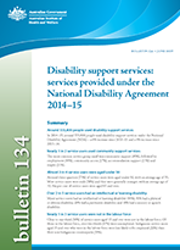Summary
Around 333,800 people used disability support services
In 2014–15, around 333,800 people used disability support services under the National Disability Agreement (NDA)—a 6% increase since 2010–11 and a 4% increase since 2013–14.
Nearly 1 in 2 service users used community support services
The most common service group used was community support (45%), followed by employment (44%), community access (17%), accommodation support (13%) and respite (11%).
Almost 3 in 4 service users were aged under 50
Around three-quarters (73%) of service users were aged under 50, with an average age of 35. Most service users were male (59%) and they were generally younger, with an average age of 32. Six per cent of service users were aged 65 and over.
Over 2 in 5 service users had an intellectual or learning disability
Many service users had an intellectual or learning disability (44%), 41% had a physical or diverse disability, 29% had a psychiatric disability and 18% had a sensory or speech disability.
Nearly 1 in 3 service users were not in the labour force
Close to one-third (30%) of service users aged 15 and over were not in the labour force. Of those in the labour force, over two-thirds (67%) were unemployed. Indigenous service users aged 15 and over who were in the labour force were less likely to be employed (22%) than their non-Indigenous counterparts (33%).
Almost 2 in 3 service users had an informal carer
Around 2 in 3 service users (65%) had an informal carer, most often their mother (72%). Over 1 in 10 service users (12%) had an informal carer who was aged 65 or over.
Around 1,900 service users transitioned to the NDIS
Around 1,900 NDA service users transitioned to the National Disability Insurance Scheme (NDIS) during the year. While the NDIS is expected to largely replace the current provision of services to people with disability under the NDA, at present most users of disability services are still receiving support under the NDA and the associated data remain the main source for reporting. These data can also provide important contextual information for the implementation and operation of the NDIS.



